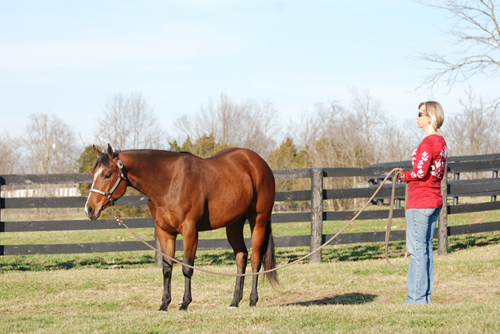
Robin Gollehon
This summer futurity enthusiasts will be lining the fence rails to watch the year’s up and coming stars display their Western Pleasure and Hunter Under Saddle talent in Yearling Longe Line classes. While scrutinizing the finished product, it is easy to forget these youngsters are in fact yearlings and many are showing for the first time. So, what goes into picking, preparing and ultimately presenting your prospect? In the second section of our in-depth four-part series, Longe Line trainers, exhibitors, owners and judges share the specifics of what they look for in a prospect, common training practices they use and how to best show your Longe Liner.
Long time AQHA Professional, Russ Smith of Whitesboro, Texas has been in the horse business for over 40 years. He has trained many National Snaffle Bit Association, American Paint Horse Association and Appaloosa World Champions in Longe Line competition as well as Congress Champions. Smith ranks number 12 on Equistat’s Top 100 all-time leading Longe Line exhibitors with earnings of $38,787.19. Also, he is a NSBA, American Quarter Horse Association and World Conformation Horse Association judge who has judged the prestigious Quarter Horse Congress and AQHA World Show 16 times.
When looking for a prospect, Smith starts evaluating yearlings in the early spring. He looks for yearlings who are fairly mature and who are often the followers in a group of horses not the pushy, bossy types that tend to be in a hurry. He also looks for good movement but explains it is very hard to make a thorough evaluation until they are started.
“Pedigree has a lot to do with it. The prospect needs to be from a Western
Pleasure or Hunter Under Saddle family that is kind of known to make good movers,” Smith says. “I usually know within four to six weeks in the training process if they are the right kind or not for Longe Line competition.”
Smith believes the Longe Line was intended to be a fundamental beginning class to find future potential not the end result. So, if a yearling seems like they don’t want to do it he sends them home.
“The number one problem I see is horses that are shown too much in the Longe Line and are not kicked out early enough if they aren’t the right kind for the class,” Smith says.
Through the years, he has gotten all kinds of prospects from those that have been over handled and spoiled to those who have never been touched. He prefers the horses who have respect for their handler and finds them the easiest to start. He first teaches his prospects “to honor his space.”
Smith also likes to be able to control all parts of their body on the ground and teaches them to flex in their head and neck. He teaches them to give their face soft each way and often uses a little Clinton Anderson training halter that is soft but can be firm if needed. He does not believe in using a chain and likes his yearlings to longe with his fingers so they do not tug on him.
“I teach them to walk first which can be one of the hardest things. I also make them stop, stand and wait,” Smith says. “If they start guessing which direction I will make them go in, I do the opposite.”
Smith commonly starts in a round pen on a 12 to 14-foot-long rope. Once the yearlings learn to honor his space and are walking well and turning both directions, he will add the jog and lope. When he feels they are getting pretty broke, he will let them play outside or pony them to keep them exercised and not over pressure them on the line. He may just go back a few days a week at that point and remind them of their training for a few minutes.
“Sometimes I see especially the Non-Pro exhibitors overdoing the training,” Smith says. “They have got to like the circle and be fresh looking.”
He grooms his prospects every day for finished conditioning as well and advises taking lots of time for ground work around your yearling. He also sometimes will haul yearlings to a neighbor’s house to get them used to different places.
When showing he recommends knowing your horse’s strengths and weaknesses and at what speed his or her movement looks the best.
“First impressions are so important when I judge so you should be appropriately dressed in sharp attire and your colt needs to be properly conditioned and fit with a nice fitting halter,” Smith says. “Your colt should be broke and you should know its abilities and how much work they need before they show.”
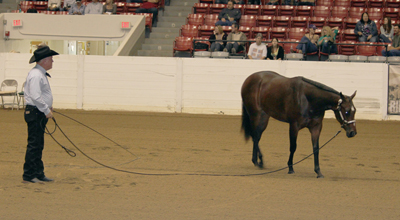
Pete Mead
Owner and exhibitor, Pete Mead of Washington, Indiana first got into Longe Line five years ago as a way to market the babies he was raising. As a Non-Pro doing all the training himself, Mead has won some of the biggest shows including championships at the Quarter Horse Congress, Tom Powers Futurity, NSBA World Show and Breeders Championship Futurity. To date, he has logged $14,818.44 in earnings.
First, Mead breaks his yearlings to longe so he can see how they move.
“The mindset is very important,” he says. ” If they have a good mind makes or breaks them to being a good or bad candidate.”
By breaking his own, Mead believes he is better able to anticipate his prospect’s next move.
“You know their little habits and they know you,” Mead says. ” You are then able to keep them in the proper gait.”
When starting a prospect, Mead typically uses a whip, longe line rope that he made himself, a chain for around the muzzle and an open area to work. He explains that first you have to teach your horse to go in a circle. A round pen can be used but is not a must for him.
“The most common stumbling block is to get them to take the right lead,” Mead says. “To address that issue, I drive them away from me before I ask them to take the right lead.”
Mead often takes his yearlings to other shows to get them accustomed to show sounds and surroundings because he feels the hardest thing to teach a horse is how to relax. He typically works his yearlings consistently and preps them for about six months to prepare for an event.
His favorite show of the year is the NSBA World Show. Besides that venue, he feels the Tom Powers and Quarter Horse Congress are the best places to show in Longe Line competition.
“I was at a show and Kenny Lakins saw me working with my horse and he asked me if he could show one of my first Longe Liners, Hez Plum Poison. He has helped ever since,” Mead says. “A Non-Pro can show though in the open if he or she wants to.”
When showing, Mead believes a good lope is the most important asset. He does not always start to the left and he does not think the gender of your prospect is an issue. He explains that the size of your prospect should not matter but it does help a great deal if your horse is mature. He recommends wearing a good hat, nice long sleeve shirt, boots, belt and jeans.
“The most challenging part of the actual showing process is to see if you can stay on the top each year,” Mead says. “The benefits of showing a Longe Liner is to see the quality of the horses you own.”
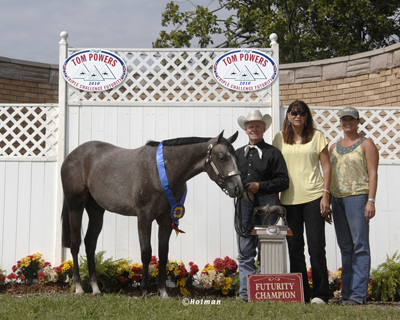
Stanley Scott
Stanley Scott of Ocala, Florida is the Equistat all-time leading exhibitor of Longe Line competition with $145,231.37 in earnings. He has shown countless successful yearlings and has had may champions at all the major shows.
He recommends patience in the training process and to always keep in mind these horses are just yearlings.
“I look for mind, movement, looks and conformation when I am going through our yearling group,” Scott says.
He likes his yearlings to be obedient but not over done, fat, slick and look like they are enjoying what they are doing when they are exhibited in the show arena. He also looks for good movement in his prospects. He recommends getting advice from a knowledgeable trainer on how to best prepare your prospect.
“Make sure your yearling is fit and ready,” Scott says. “You can also come visit us at Haylo Farm and I will show you what I look for in a good Longe Line prospect!”
A professional horse trainer for over 40 years, Gord Wadds of Ovid, Michigan has been showing in the Longe Line class since the very beginning. Since Equistat began keeping records in 1994, Wadds has earned over $45,000 in Longe Line competition landing him the number eight spot on the top exhibitors of all-time in the class. This year, Wadds is very excited to introduce his 2014 Tom Powers entry, Tom Kruzer by AQHA Superhorse, The Krymsun Kruzer.
When looking for the ideal Longe Line candidate, Wadds first looks for balance in movement, conformation and mental attitude.
“No matter how pretty they move and look, a bad attitude eliminates all the pretty in world,” Wadds says.
When training Wadds begins potential candidates between six and twelve months of age depending on strength and mental maturity.
“We have found that the younger we start very short sessions usually no more than five to 10 minutes with lots of walking, the shorter and easier the sessions can be throughout a careful continuation right through to a show ready Yearling Longe Line candidate,” Wadds explains. “Our rule of thumb with the youngsters is the same as it is with 2 and 3-year-old Western Pleasure prospects, if it isn’t easy for them mentally and physically then we don’t do it.”
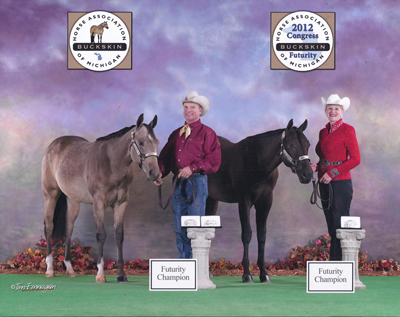
Gord Wadds
For Wadds, he would ideally like to start formal longe line training early in the year and frequently uses a round pen.
“We begin our training in a round pen. We have an indoor round pen that is 45 feet in diameter,” Wadds says. “Once weather permits, we have a 45-foot and a 60-foot round pen right beside our 80-by-250-foot outdoor arena.”
Wadds also uses the ” Wadds Way” training halter system right from the first session and claims he wouldn’t want to train without it.
“It will spoil you,” Wadds proclaims.
The halter is designed to provide immediate reward light response and comfortable control without resentment which he had experienced using a chain. He explains that the optional ” lateral control” cord snaps on the offside nose band ring then comes over the poll to the near nose band ring to the handler. It is designed to automatically lower the head and neck and requests response to the inside from both sides of the nose band and poll.
Also included is a training and showing longe line that features braided buttons at five foot increments up to 25-feet so the handler is always aware how far their yearling is from them. Anyone interested in the product made by Master Craftsman to supplement training for longe liners, showmanship horses and horses that pull while longing should visit www.gordwadds.com. Wadds also outlines his online course and personal training sequence with the Wadds Way training halter on his website.
Robin Gollehon of Versailles, Kentucky has won all the major NSBA futurities and the Quarter Horse Congress. Over her many years in the business she has won $23,081.77 in Longe Line earnings alone ranking her 23rd on Equistat’s top Longe Line exhibitors list. She and husband, Roger train, raise and show pleasure horses specializing in Longe Line with their Yearling Head Start Program, Getting Ready to Ride series which is groundwork preparing for life under saddle and offer training for the finished horse and advanced rider. They now stand NSBA Horse of the Year, NSBA World Champion and AQHA Reserve World Champion, Good Cowboy Margarita to the public.
When picking an ideal candidate for the class, Gollehon looks for a big, pretty, good minded prospect who has extremely good movement and movie star charisma.
“Obviously, the most important trait would be movement but if they aren’t willing, it doesn’t matter how good a mover they are,” Gollehon says. “I had a gelding several years ago that I just loved. He was gorgeous to look at and a very pretty mover. The very first time I showed him, he surprised me by pinning his ears flat back as I jogged him away from the judges in the Halter portion of the class. He did not want to do it and I never showed him in Longe Line again.”
At the beginning of the training process, Gollehon teaches “whoa before we go.” She spends a lot of time at the standstill getting the yearlings used to her standing by their side while they stand at a profile.
“Most young horses want to turn and face you which is what the natural horsemanship guys capitalize on but that will really mess up a longe liner because it’s so important that they don’t face you,” Gollehon says. “I start off pretty close to them but gradually I get all the way out at the end of the line and I can walk from one side of them all the way around to the other side without them moving. From there we add the walk, practicing whoa, then jog, etc. I don’t ask them to reverse because that involves them facing me until they’re locked in on standing profile. I have a couple different lengths of longe lines and start off with one that’s fairly short. I use a stud chain around their nose and snapped back to itself so it’s there if I need it.”
Although Gollehon does not feel using a round pen is a must, she finds it very helpful in the beginning especially with yearlings who want to give their face but not their body. In the training process, Gollehon finds the most common stumbling block is to teach them to respect the circle. She commonly addresses this issue in stages with her youngsters. At first, she will make things easy working inside in a roundpen with little distractions. Gradually as they respond to training and have learned the basics, she will go outside where there is more going on.
“At first, I’ll turn them out before working but as they get more broke, I’ll teach them to control their energy by working when they’re fresh,” Gollehon says. “If there are problems I’ll take them back a step or get them a little tired.”
Ideally, Gollehon likes to have at least six months to get her yearlings ready to show. She explains preparing for a Longe Line class is not just the longing part but also includes a lot of physical conditioning.
“My Yearling Head Start Program is more a way of life than a rigorous training program so it’s not harmful to their minds or legs,” Gollehon says. ” It also depends on what and how much has been done with them before I get them.”
Gollehon finds the most challenging part of the actual showing process is to know how much to prepare ahead of time. In turn, she believes it is extremely important to take yearlings to a show setting to prepare.
“As I said earlier, once they are doing well in one place, I’ll advance them by taking them somewhere with more distractions. Ultimately, that’s a horse show and if they’ve never been hauled before, it can take a few shows before they settle in,” Gollehon says.
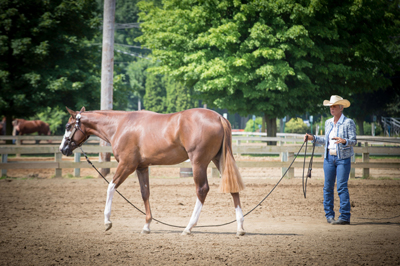
Kathie Kennedy
Kathie Kennedy of Reddick, Florida has been showing in Longe Line competition for over 20 years. She is second on the Equistat all-time leading Longe Line exhibitor standings with $99,456.57 in total earnings through 2013. A trainer since the mid-80s, Kennedy began competing in the Longe Line classes in 1993 and soon made the class a priority in her business by the mid-90s. She has trained numerous Congress, NSBA World, Breeders Cup Futurity and APHA World Champions as well as 10 NSBA Honor Roll horses. Commonly, she shows at the Tom Powers, NSBA World, Quarter Horse Congress and APHA World Show where she feels yearlings can best be showcased.
Kennedy spends a lot of time in the round pen, with the mule ponying and on the walker. She works one gait at a time never moving onto the next until she is happy with it. She also explains that she very rarely uses any equipment other than a longe line.
“Maturity and physical ability go hand in hand in the process. The prospect always tells me if I am going too fast,” Kennedy says. “We all need to remember that these are babies and we need to treat them like athletes in training. Their minds and ability are so different in each other. It’s sometimes a game to find the correct way to convince them it’s their idea, slow and consistent.”
In the training process, Kennedy says she finds it hard to pinpoint what the hardest part to teach one is because they are all so different.
“Ninety days is always a critical time in the yearling process. Some can be ready to show at that time and some it’s a longer process but the natural ones always win out,” Kennedy says.
When showing in the conformation portion of the class, Kennedy looks at hock set, how their neck ties into their wither, how strong they are across the croup, if they walk nice and flat footed and how they swing their leg as they walk forward.
“The judge wants to see the over all picture as if they are looking at a prospect in the pasture,” Kennedy says. “When it comes time for that 45 seconds each way make sure you know your yearling and try to make an impression of its strongest qualities. Soft and smooth are very important.”
To Kennedy, the most challenging part of the actual showing process is trying to help the yearling find its most comfortable circle radius at all three gaits. Excessive whip cracking is a pet peeve of hers she explains and she does not like when exhibitors over show their horse. The most common mistake she sees exhibitors make when showing is not having enough forward motion in their prospects. She recommends yearlings be more forward because the slowest horse is not usually the winner.
When looking for a prospect, Kennedy looks for movement and conformation.
“They have to be a good loper these days. A jog is also important but the prospect can maybe cover some ground without being noticed as much but they have to lope or canter,” Kennedy says. “Size and conformation should play a role in the class but it is all in the balance of the yearling. They should look like all the parts belong.”
The gender of her prospect does not matter to Kennedy as long as they are mannerly. For attire, she recommends wearing something that is comfortable to you.
“The class has really changed over the past 20 years and even over the past five,” Kennedy says. “It’s not a discipline class like it used to be and it should not be. It’s to showcase the movement of your yearling as a potential prospect for either the Western Pleasure or Hunter Under Saddle futurities.”
Lynn Campbell of Pittsboro, Indiana has successfully shown in Longe Line competition for many years and it has landed her number 31 on the Top100 exhibitors in Longe Line with $17,442.28 in total earnings.
“For me being around them as babies is very helpful to get a check on their temperament and trainability,” Campbell says. “The ones I raised I just tried them out late in their weanling year around the farm or maybe in the round pen a few times. The ones I bought in the fall were a bit different, obviously the breeding is the first indicator and seeing their size, balance, conformation and temperament when you are looking is a key priority. I was very lucky that those I bought babies from knew what I was wanting to do with them so they steered me in the right direction on ones to look at.”
When looking for a successful Longe Line prospect, Campbell looks for eye appeal and temperament. She does not like Longe Line prospects to be anxious or fretful.
“If their conformation is correct and they are pretty you are way ahead to start,” Campbell says. “If they enjoy people and are easy to be around, my experience has been you can teach them the program pretty easy.”
Through the years, Campbell has trained some of her yearlings on her own, sent some of them out to trainers or done a little of both.
“When training your own, you really get a chance to know the colt and are able to read them. They will tell you most everyday what kind of mood they are in. For me I have found doing a lot of the preliminary ground work, getting them to know cluck, kiss and whoa in the fall makes starting again in the late winter a bonus,” Campbell says. “That is usually when I send them out for 60 to 90 days to really get them in a consistent routine of having a job.”
Campbell does a lot of work with her babies from the time they are little. She finds the more work she does with them at an early age the easier they are down the road. She works a lot on leading, standing and teaching them what whoa means. She also believes in using a round pen and introduces them to it at an early age. She uses a smaller, controlled round pen that is 60 ft. in diameter.
“I like to think that 90 days should be ample time for most colts to really be ready to go show but realizing they are like a puzzle and many pieces have to be put in place to build that puzzle to come together,” Campbell says. “I may start putting the pieces together six months before I ever go to a show. Over the winter, I may take them for a trailer ride to friends for a day or even for the weekend to get them in a new place, hear and see other horses and also to gauge that temperament.”
For Campbell, the hardest issue is timing mental maturity and growth, which can cause a pause in her work routine. To address this issue, she may work through it or lay off of the yearling to let their body catch up and strengthen. She finds the most challenging part to teach the horse is consistency of the maneuver she is working on and explains it all takes time, practice and patience.
She believes both the jog and lope are important. When showing she usually starts to the left because she sets up that direction but recommends starting in the direction you are comfortable with may be in your best interest. She advises exhibitors to wear a neat and tidy blouse, vest or jacket for women. As for men, she prefers a nice shirt with a tie or scarf and at the larger events a sport coat.
“Go watch, talk to exhibitors or friends who have done it and give it a whirl,” Campbell says. “It’s really a fun process culminating with the show.”


You must be logged in to post a comment Login